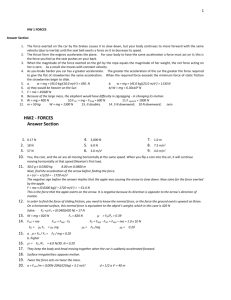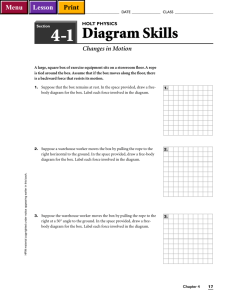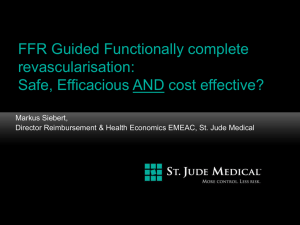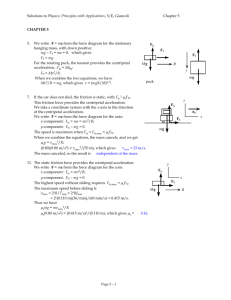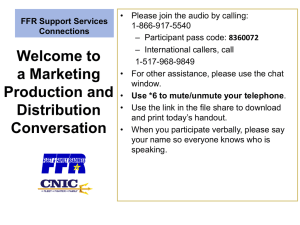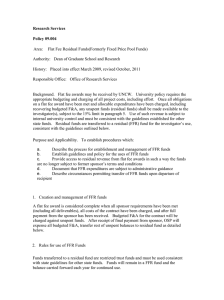Document 13726067
advertisement
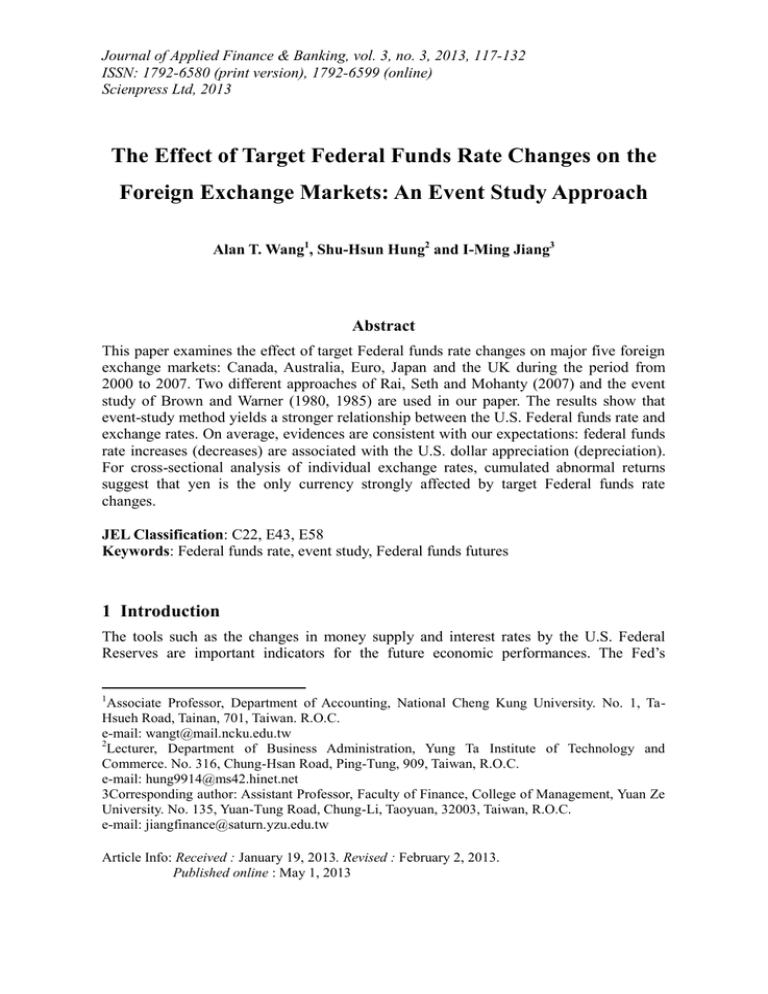
Journal of Applied Finance & Banking, vol. 3, no. 3, 2013, 117-132 ISSN: 1792-6580 (print version), 1792-6599 (online) Scienpress Ltd, 2013 The Effect of Target Federal Funds Rate Changes on the Foreign Exchange Markets: An Event Study Approach Alan T. Wang1, Shu-Hsun Hung2 and I-Ming Jiang3 Abstract This paper examines the effect of target Federal funds rate changes on major five foreign exchange markets: Canada, Australia, Euro, Japan and the UK during the period from 2000 to 2007. Two different approaches of Rai, Seth and Mohanty (2007) and the event study of Brown and Warner (1980, 1985) are used in our paper. The results show that event-study method yields a stronger relationship between the U.S. Federal funds rate and exchange rates. On average, evidences are consistent with our expectations: federal funds rate increases (decreases) are associated with the U.S. dollar appreciation (depreciation). For cross-sectional analysis of individual exchange rates, cumulated abnormal returns suggest that yen is the only currency strongly affected by target Federal funds rate changes. JEL Classification: C22, E43, E58 Keywords: Federal funds rate, event study, Federal funds futures 1 Introduction The tools such as the changes in money supply and interest rates by the U.S. Federal Reserves are important indicators for the future economic performances. The Fed’s 1 Associate Professor, Department of Accounting, National Cheng Kung University. No. 1, TaHsueh Road, Tainan, 701, Taiwan. R.O.C. e-mail: wangt@mail.ncku.edu.tw 2 Lecturer, Department of Business Administration, Yung Ta Institute of Technology and Commerce. No. 316, Chung-Hsan Road, Ping-Tung, 909, Taiwan, R.O.C. e-mail: hung9914@ms42.hinet.net 3Corresponding author: Assistant Professor, Faculty of Finance, College of Management, Yuan Ze University. No. 135, Yuan-Tung Road, Chung-Li, Taoyuan, 32003, Taiwan, R.O.C. e-mail: jiangfinance@saturn.yzu.edu.tw Article Info: Received : January 19, 2013. Revised : February 2, 2013. Published online : May 1, 2013 118 Alan T. Wang, Shu-Hsun Hung and I-Ming Jiang monetary policy is widely recognized as having significant influences on the on the world stock markets. In particular, the announcements by the US Federal Open Market Committee (FOMC) for target Federal Funds rate (FFR) changes have direct and immediate impacts on the financial markets around the world. It is documented that FFR is a good indicator of monetary policies and a particularly informative nominal interest rate for future real economic variables (Bernanke and Blinder (1992)). From the perspective of firms, unexpected changes in FFR will affect costs of capital for firms, which in turn will affect stock markets and foreign exchange markets. Given that the US is the largest economy in the world and the states of the U.S. economy are directly linked to the rest of the world, announcements of target FFR change by FOMC are tightly watched by the other countries’ central banks and investors. The effects of macroeconomic news announcements on the financial markets have been extensively documented in the literature. In particular, the effects of macroeconomic announcements on interest rates, equity markets and foreign exchange markets have been scrutinized. For example, the effects macroeconomic news announcements on interest rates are recently documented by Ederington and Lee (1993), Becker, Finnerty and Kopecky (1995), Seiler et al. (1998), Fleming and Remolona (1999), Faust et al. (2007), and Rai, Seth and Mohanty (2007), among others. The general finding is that short-term interest rates are more responsive to macroeconomic news than long-term interest rates. MacQueen and Roley (1993), Jensen and Johnson (1995), and Kaen, Sherman and Tehranian (1997) report the effects of macroeconomic news announcements on equities. They tend to find that stock market react positively (negatively) to a decrease (increase) in discount rate or FFR, but the degree varies. Effects of macroeconomic announcements on exchange rates are reported by literature such as Hakkio and Pearce (1985), Ederington and Lee (1993), Evans (1994), Eichenbaum and Evans (1995), Lewis (1995), Almeida et al. (1998), Andersen and Bollerslev (1998), Bonser-Neal, Roley and Sellon (1998), Andersen et al. (2003), Ehrmann and Fratzscher (2005), Evans and Lyons (2005), Faust et al. (2007) and the references therein. Hakkio and Pearce find that short-term spot rate is systematically related to unexpected components of economic announcements but not related to news on inflation or real activities after October 1979 when the Fed switched operating procedures. With higher frequency data, Ederington and Lee conclude that macroeconomic news announcements are responsible for the observed time-of-day and day-of-the-week volatility patterns in interest rate and exchange rate futures markets. Evans reports that the maximum dollar appreciation against Deutsche mark and Japanese yen occurs from 2 to 3 years after the positive FFR shock with weekly data. Using biweekly data, Lewis finds the immediate impacts of monetary measures including FFR, nonborrowed reserves and narrowly defined money supply M1 are statistically insignificant. Eichenbaum and Evans conclude a contractionary shock to US monetary policy leads to persistent appreciation in the nominal and real US exchange rate even the initial appreciation in respond to contractionary policy shock is small. Andersen et al. (2003) find that foreign exchange rate responses to macroeconomic announcement more to bad news than good news. Bonser-Neal, Roley and Sellon argue that exchanges rates immediately respond to macroeconomic policy actions and these are consistent with the overshooting hypothesis. Evans and Lyons (2005) conclude that currency markets are absorbing news after several days. In this study we focus on the effect of changes in FFR announcements on exchange rates between the US dollar and other major foreign currencies. It provides important Target Federal Funds Rate Changes on the Foreign Exchange Markets 119 implications for foreign central banks and foreign exchange market participants because the announcements of the US FFR changes are often followed by the announcements of interest rate changes by foreign central banks for maintaining the stability of exchange rates. Federal Funds rate and discount rate are both monetary policy tools for the US Fed. It is possible that discount rate changes also have impacts on exchange rates. However, FFR has been the major monetary policy tool and the public media also focus on the FOMC’s decision for FFR targets. Besides, Brown (1981) suggests the information contained in discount rate is predictive by FFR. Even though the effect of target FFR change announcements on exchange rates is not new in literature, we apply an alternative approach to examine the effects of FFR target announcements on foreign exchange markets around the announcement day. Previous studies often apply the method of regression (such as Hakkio and Pearce (1985), Ederington and Lee (1993), Almeida et al. (1998)) or vector autoregreesion (VAR) models (such as Evans (1994), Eichenbaum and Evans (1995), Lewis (1995)). Instead we apply the event-study approach of Brown and Warner (1980, 1985) which is widely applied in corporate finance to examine how FFR announcements affect foreign exchange markets around the announcements. Our event-study method differs from others such as Fatum and Hutchison (2003) and Fratzscher (2008) in which sign tests and matched sample tests are used. Event-study method helps us understand how the FFR announcements affect the foreign exchange markets around the announcement day. Rai, Seth, and Mohanty (2007) (RSM) studies the impact of official discount rate changes on market interest rates. RSM method captures not only the announcement effect but also the anticipatory and learning effect. RSM examines several time intervals to capture the announcement, anticipatory and learning effects. The immediate impact of the announcement, defined as announcement day effects, is captured from day t -1 to day t +1, where t is announcement day. The anticipatory effects are captured by estimating market responses up to one week, or 5 business days prior to the announcement day. Anticipating the possible actions of the monetary authorities (Fed watching) is now an integral job function for most investment analysts and portfolio managers. Considerable speculation and adjustments to buy and sell portfolios take place prior to the scheduled meetings of regulators. For learning effect, if no official explanations are provided, market participants have to determine whether the changes are technical or non-technical and whether they are permanent or temporary. Responses may lag if markets require time to determine the relevant information in each announcement, defined as learning effects. Thus, the announcement effects of fed funds rate changes is separated into three components: anticipatory effects (day t -5 to day t-2), announcement-day effects (day t -1 to day t +1), learning effects (day t+2 to day t +5), and total effects (day t -5 to day t +5). Because the event-study method we are going to apply also examines how foreign exchange market reacts to FFR changes around the announcement day, it would be informative to contrast the results from event-study method with the results from RSM method. As a result, we investigate the effect of FFR change on foreign exchange markets with RSM approach as well as event-study approach. 120 Alan T. Wang, Shu-Hsun Hung and I-Ming Jiang 2 Data and Methodology 2.1 Data The effects of target Fed funds rate changes on exchange rate markets are examined for the period from January 2000 to December 2007. Exchange rates are defined indirect exchange rate. That is, the exchange rate is defined as the foreign currency price per US dollar. The exchange rates examined are the major currencies: Canada dollar, Australia dollar, Euro, British pound, and Japanese yen. Daily exchange rate data are collected from Datastream. In addition, we need short-term rate data to use for IRP model in event study. The short-term interest rate data including 1-month Commercial Paper rate for the US, 1month T-Bill rate for Canada, 1-month Deposit rate for Australia, 1-month Euribor, 1month Deposit rate for UK, and 1-month Certificate Deposit rate for Japan. Daily interest rates are also collected from Datastream. In our we also examine whether the abnormal returns in exchange rates are more affected by deviation of the target FFR and market expectations. In order to capture the expected FFR, federal funds futures price is used as a vehicle to measure market’s expectation of the actual FFR change. Because overnight FFR futures are no longer traded, we use threemonth futures prices traded on CBOT to proxy market expectations for FFR. FFR Futures prices are collected from Datastream. The observations of target FFR changes which comprises of 20 rate increases and 16 rate decreases during our sample period is available from the website of Federal Reserve Bank of New York. Table 1 shows the announcement dates and the respective target rates. In order to have enough number of days for the estimation period in the event-study approach (we discuss later), if an FFR change follows the last FFR change in less than a month, then we eliminate the FFR change as an event. As a result, four FFR decreases in 2001 have been dropped from our sample: 4/18/2001, 5/15/2001, 9/17/2001 and 10/2/2001. Event date 2000/2/2 2000/3/21 2000/5/16 2001/1/3 2001/1/31 2001/3/20 2001/4/18 2001/5/15 2001/6/27 2001/8/21 2001/9/17 2001/10/2 2001/11/6 2001/12/11 2002/11/6 Table 1: Target Federal Funds Rate Changes (2000-2007) Day From (%) To (%) Change (%) Mon 5.5 5.75 +0.25 Tue 5.75 6 +0.25 Tue 6 6.5 +0.5 Wed 6.5 6 -0.5 Wed 6 5.5 -0.5 Tue 5.5 5 -0.5 Wed 5 4.5 -0.5 Mon 4.5 4 -0.5 Wed 4 3.75 -0.25 Tue 3.75 3.5 -0.25 Mon 3.5 3 -0.5 Tue 3 2.5 -0.5 Tue 2.5 2 -0.5 Tue 2 1.75 -0.25 Wed 1.75 1.25 -0.5 Target Federal Funds Rate Changes on the Foreign Exchange Markets 2003/6/25 2004/6/30 2004/8/10 2004/9/21 2004/11/10 2004/12/14 2005/2/2 2005/3/22 2005/5/3 2005/6/30 2005/8/9 2005/9/20 2005/11/1 2005/12/13 2006/1/31 2006/3/28 2006/5/10 2006/6/29 2007/9/18 2007/10/31 2007/12/11 Wed Wed Tue Tue Wed Tue Wed Tue Tue Thu Tue Tue Tue Tue Tue Tue Wed Thu Tue Wed Tue 1.25 1 1.25 1.5 1.75 2 2.25 2.5 2.75 3 3.25 3.5 3.75 4 4.25 4.5 4.75 5 5.25 4.75 4.5 1 1.25 1.5 1.75 2 2.25 2.5 2.75 3 3.25 3.5 3.75 4 4.25 4.5 4.75 5 5.25 4.75 4.5 4.25 121 -0.25 +0.25 +0.25 +0.25 +0.25 +0.25 +0.25 +0.25 +0.25 +0.25 +0.25 +0.25 +0.25 +0.25 +0.25 +0.25 +0.25 +0.25 -0.5 -0.25 -0.25 2.2 Methodology 2.2.1 Rai, Seth, and Mohanty (2007) approach RSM examines how the FFR change affects interest rate around the announcement day. Following their approach, we first examine how FFR change affects exchange rate by the following regression: st1 ,t2 FedTargett ut (1) where st1 ,t2 is the log change of exchange rate from day t1 to day t 2 , FedTargett is change in target FFR at day t , and u t is the error term. To save space, we present results for only six intervals in Table 2 (for rate increases) and Table 3 (for rate decreases): (t-5 to t-2), (t-1 to t), (t to t+1), (t+2 to t+5), (t-1 to t+1) and (t-5 to t+5), where t indicates the announcement day of target FFR change. Market responses to Fed funds rate announcements between day t-1 to day t+1 capture the announcement-day effects. Market responses prior to the announcement day, or from day t-5 to day t-2, capture the anticipatory effects. Market responses from day t+2 to day t+5 capture the learning effects. Total market responses from day t-5 to day t+5 capture the total effects. Although the RSM method is easy to implement and easy to identify how exchange rates react to FFR changes for any time interval of interest, there are certain technical problems, however. In our case FFR change is the independent variable in the regression, 122 Alan T. Wang, Shu-Hsun Hung and I-Ming Jiang and it suffers the problem that the independent variable is not “variable” enough. Thus the standard errors of the coefficient estimates will be too large. Besides, foreign exchange rates can be affected by domestic and foreign interest rates even in the short term, but RSM approach does not take the effect of bilateral interest rates into account. 2.2.2 Event-study approach The event-study method such as Brown and Warner (1980, 1985) has been extensively and successfully applied in corporate finance. For example, to investigate whether a merger and acquisition announcement is a good news or bad news for acquiring firms or target firms, event study approach can be applied to examine how the stock market reacts to such announcement. By examining the so-called “abnormal returns”, which is the deviation from the expected return from the benchmark model (e.g., the market model), we can acknowledge whether the announcement of a certain event is, on average, a good news (with positive abnormal returns) or bad news (with negative abnormal returns) for a sample of firms with the same announcement around the announcement day. In this study, we adapt the event-study method to foreign exchange market. The “event” we define here is the FFR changes. For each exchange rate, we use a maximum of 41 daily observations for the period around its respective event. The first 30 days in the period (-35 to -6) is designated the “estimation period”, where day 0 is the announcement or event day. And the following 11 days in this period (-5 to +5) is designated “event period”. If the number of business days between two FFR changes is not large enough, we will have fewer days for the estimation period. To avoid too few days for estimation, if an FFR change is followed by another FFR change within less than one month, then we drop the second FFR change from our sample. It may be questioned that the estimation and event periods are not long enough. However, measuring exchange rate changes over a short window surrounding FFR changes reduces the likelihood that any exchange rate changes are due to some other economic factors not included in our models. In the event-study approach, the OLS market model is often used in corporate finance literature to estimate security i’s abnormal returns (AR). For example, to compute the AR for a given event, we first estimate the market model in the estimation period and then compute the AR for security i in the event period: ARi ,t Ri ,t aˆi bˆi Rm,t (2) where Ri ,t is the return on stock i for day t in the event period, Rm,t is the return on the market index for day t in the event period, and â i and b̂i are OLS values from the estimation period. To find the corresponding counterpart in the foreign exchange market, a natural candidate we use here is the model in the spirit of the well-known uncover interest rate parity (UIP) condition. Whether UIP is valid or not is an empirical issue. However, we use it as a predictor for future exchange rate movement in the short-term. We first estimate the following regression in the estimation period: si,t 1 si ,t 1 si ,t i i (ri ,t rUS,t ) i ,t 1 (3) where si ,t denotes the log exchange rate for country i on day t . ri ,t and rUS ,t denote the interest rates for country i and the U.S. on day t respectively. i,t is the error term. Then Target Federal Funds Rate Changes on the Foreign Exchange Markets 123 we define the following abnormal return for foreign exchange market i in the event period: ARi ,t si ,t ˆ i ˆi (ri ,t 1 rUS ,t 1 ) (4) where ̂ i and ˆ i are OLS values of eq.(3) from the estimation period. The null hypothesis to be tested is that the abnormal return of the event day is equal to zero and the test statistic is t-statistic. The test statistic is the ratio of the abnormal return to its estimated standard deviation; the standard deviation is estimated from the time series of mean abnormal returns. Adapted from Brown and Warner (1985), the Student-t is used to test the significance of the daily abnormal returns during the event period: t ARt / Sˆ ( ARt ) and AR t 1 N (5) N AR i ,t i 1 , Sˆ ( AR t ) ( 6 ( ARt AR)2 / 29 , AR t 35 1 6 ARt , 30 t 35 where the degree of freedom is 29. The mean cumulative abnormal return ( CAR ) for over k days from t1 to t k is then calculated as follows: tk CAR t1 ,tk AR t . t t1 The significance of CARt1 ,t2 is tested with: tk t AR t t t1 tk Sˆ 2 ( AR t ) (6) t t1 The test statistic is assumed to be distributed Student-t with 29 degrees of freedom. Other than that the methods in RSM and event-study approaches differ, there is another important difference between these two methods: RSM approach is to find the average of FFR changes over all the events in our sample for each currency; the event-study approach we apply here is to find the average of FFR changes over all the sample currencies for each event. 3 Empirical Results 3.1 RSM Approach Using RSM approach, by regressing exchange rate change on target FFR change, we report the results in Table 2 and Table 3 for rate increases and decreases respectively. It is shown that for rate increases in Table 2, only Canada and Australia currencies show significant results at the conventional significance levels. In particular, for these two currencies, significant results are more prominent in the after-announcement period. This suggests that the effects of target FFR change on exchange rate change are more attributable to learning effects. It suggests that foreign exchange markets take time to incorporate information revealed by the target FFR changes. However, for Canada and 124 Alan T. Wang, Shu-Hsun Hung and I-Ming Jiang Australia, the signs are all negative for significant coefficients. This is inconsistent with our expectation, in which US dollar should appreciate against other currencies when target FFR increases. For the case of rate decreases in Table 3, only Canada has marginally significant result for the period from day t+2 to day t+5. The sign of the significant coefficient is negative, consistent with our expectation: target FFR decrease is associated with a depreciation of the US dollar. Table 2: Exchange rate reactions around target Fed funds rate increases Interval Beta (t1 , t k ) Canada Euro UK Japan Australia t-5 to t-2 t-1 to t t to t+1 t+2 to t+5 t-1 to t+1 t-5 to t+5 -0.1866 -0.1339 -0.0090 -0.1317*** -0.0182 -0.1862*** -0.2809 -0.2325 0.0401 -0.1120 0.0159 -0.1837* -0.1776 -0.1836 0.0263 -0.0967 0.0054 -0.1132 -0.1255 -0.0576 0.0142 -0.0155 0.0181 -0.0789 -0.1457* -0.1387 -0.0476 -0.2242** 0.0099 -0.3699*** Notes: 1. For each interval, t1 and t 2 indicate the days relative to the announcement day of target FFR change t. 2. The number of observations is 20. 3. Numbers in parentheses are t-statistics. ***, **, * indicate significant at 1%, 5% and 10% significance levels, respectively. 4. Estimates are adjusted for autocorrelations and heteroskedasticity in errors. Overall, RSM approach suggests that, by aggregating the effects of target FFR changes over all the events for each currency, only a few cases show significant results. It is possibly due to the fact that the conditions of foreign exchange markets vary over time, and thus the effects of target FFR change on foreign exchange markets may vary over time (positive or negative). Thus aggregating the effects of all the target FFR changes for each currency may possibly even out foreign exchange market reactions. Table 3: Exchange rate reactions around target Fed funds rate decreases Interval Beta (t1 , t k ) Canada Euro UK Japan t-5 to t-2 t-1 to t t to t+1 t+2 to t+5 t-1 to t+1 t-5 to t +5 -0.0468 0.0134 -0.0138 -0.0510* -0.0005 -0.0978 -0.0001 -0.0047 0.0165 0.0110 0.0117 0.0109 0.0111 -0.0064 0.0200 0.0231 0.0137 0.0343 0.0710 -0.0015 0.0041 0.0399 0.0027 0.1109 Australia -0.0161 -0.0178 0.0173 0.0783 -0.0005 0.0622 Notes: 1. The number of observations is 11. 2. Numbers in parentheses are t-statistics.* indicates significant at 10% significance level. 3.2 Event-study approach Table 4 and Table 5 report the results of average exchange rate abnormal returns for all the target FFR increases and decreases respectively over the period from 2000 to 2007. Because the exchange rate defined here is the foreign price per US dollar. We expect an increase in the US interest rate is associated with a US dollar appreciation. During this Target Federal Funds Rate Changes on the Foreign Exchange Markets 125 period, there has been 20 target FFR increases according to the results reported in Table 4. Of the 20 target FFR increases, there are 12 target FFR increases associating with significant CAR on day t+5, which captures the total effect. Only 1 of these significant CARs at is negative. As a result, for total effect (day t-5 to t+5), it is quite consistent with our expectations. For the pre-announcement period, there are 9 significant CARs (day t-5 to day t-2) and 3 of these are negative. By observing the ARs from day t-1 to day t+1, 11 events are significant and 4 of these are negative. For ARs in the post-announcement period (day t+2 to day t+5), 13 are significant and 5 of these are negative. In sum, learning effect is more prominent than anticipatory and announcement-day effects. During the sample period, there has been 11 target FFR decreases. We expect target FFR decreases are associated with the U.S. dollar depreciation. According to Table 5, there are 7 significant total effects by observing significant CARs from day t-5 to day t+5, and 3 of these CARs are positive. For anticipatory effect (day t-5 to day t-2), there are four significant CARs and 2 of these are positive. For announcement-day effect (day t-1 to day t+1) and learning effect (day t+2 to day t+5), we find significant ARs for 7 events and 2 of these are positive for both periods. Overall, even though the results are consistent with our expectation, the justification that interest rate decreases are associated with the U.S. dollar depreciation is not as strong as the cases for interest rate increases. 3.3 Cross-sectional Analysis In traditional event-study approach, cross-sectional analysis is also widely applied to examine to what extent that certain variables of interest are associated with the abnormal returns. In this study, we consider two variables to examine how and to what extent these variables are related to the abnormal returns: target FFR change and FFR change implied by federal funds futures price. The choice of the first variable is natural. The choice of the second variable is to capture the deviation between market’s expectation and the actual target FFR change (see, for example, Kutnner (2001)). 126 Alan T. Wang, Shu-Hsun Hung and I-Ming Jiang Table 4: Average exchange rate abnormal returns around target Fed funds rate increases Event date 2/2/2000 3/21/2000 AR CAR AR CAR 5/16/2000 6/30/2004 8/10/2004 9/21/2004 11/10/2004 12/14/2004 2/2/2005 3/22/2005 5/3/2005 6/30/2005 8/9/2005 9/20/2005 11/1/2005 12/13/2005 1/31/2006 3/28/2006 AR CAR AR CAR AR CAR AR CAR AR CAR AR CAR AR CAR AR CAR AR CAR AR CAR AR CAR AR CAR AR CAR AR CAR AR CAR AR t-5 -0.0005 -0.0005 -0.0009 (-0.35) -0.0009 (-0.35) -0.0016 -0.0016 0.0007 0.0007 -0.0045 -0.0045 -0.0002 -0.0002 -0.0049 (-1.43) -0.0049 0.0036 -0.0016 -0.0020 -0.0020 0.0030 -0.0030 0.0043 0.0043 0.0030 0.0030 -0.0037 -0.0037 (-0.81) 0.0003 0.0003 -0.0082** -0.0082** -0.0012 -0.0012 0.0040 0.0040 0.0048 Days relative to event day t t-4 t-3 t-2 t-1 t t+1 t+2 0.0019 0.0024 0.0098*** 0.0055** 0.0053** -0.0011 -0.0006 0.0015 0.0039 0.0137*** 0.0192*** 0.0245*** 0.0235*** 0.0228*** -0.0043 0.0028 0.0033 0.0018 -0.0019 0.0041 -0.0006 (-1.65) (1.08) (1.28) (0.71) (-0.75) (1.57) (-0.21) -0.0052 -0.0024 0.0009 0.0028 0.0008 0.0049 0.0043 (-1.42) (-0.53) (0.18) (0.48) (0.13) (0.71) (0.59) -0.0011 0.0044* -0.0077*** -0.0009 0.0046* 0.0079*** -0.0001 -0.0027 0.0016 -0.0061 -0.0069 -0.0023 0.0055 0.0054 -0.0037 -0.0012 0.0003 0.0052 0.0015 -0.0028 -0.0033 -0.0030 -0.0042 -0.0039 0.0013 0.0028 -0.0000 -0.0033 -0.0019 -0.0022 -0.0073* -0.0067* -0.0019 0.0034* -0.0027 -0.0064 -0.0086 -0.0159** -0.0226*** -0.0245*** -0.0211** -0.0237** 0.0074** 0.0018 0.0020 0.0045 0.0001 0.0027 0.0007 0.0072 0.0090* 0.0110* 0.0155** 0.0156** 0.0183** 0.0190** -0.0038 -0.0027 -0.0045 0.0032 -0.0006 0.0025 -0.0049 (-1.12) (-0.80) (-1.33) (0.93) (-0.17) (0.73) (-1.42) -0.0087* -0.0114* -0.0159** -0.0128 -0.0134 -0.0109 -0.0157 0.0097*** 0.0039 0.0053** -0.0030* -0.0013 -0.0056** -0.0006 0.0133*** 0.0173*** 0.0226*** 0.0196*** 0.0184*** 0.0127* 0.0121 -0.0007 0.0021 0.0021 0.0030 0.0005 0.0047 0.0046 -0.0028 -0.0006 0.0015 0.0044 0.0049 0.0097 0.0143 -0.0043 0.0005 0.0041 0.0056 0.0015 0.0088** 0.0043 -0.0013 -0.0008 0.0033 0.0089 0.0104 0.0192** -0.0234** 0.0043 0.0021 0.0024 0.0036 0.0051* -0.0000 0.0029 0.0086 0.0107** 0.0132** 0.0168** 0.0218*** 0.0218** 0.0247*** 0.0025 0.0006 0.0058 0.0044 0.0031 0.0094** 0.0100*** 0.0055 0.0061 0.0119* 0.0163** 0.0194** 0.0288*** 0.0389*** -0.0023 -0.0041 0.0023 0.0002 -0.0010 -0.0038 -0.0079* -0.0060 -0.0101 -0.0078 -0.0076 -0.0086 -0.0124 -0.0203 (-0.93) (-1.28) (-0.85) (-0.74) (-0.77) (-1.03) (-1.56) -0.0015 0.0043 -0.0010 -0.0005 -0.0026 -0.0037 0.0010 -0.0012 0.0032 0.0022 0.0017 -0.0010 -0.0047 -0.0037 -0.0030 -0.0037 0.0005 0.0039 -0.0004 -0.0033 0.0004 -0.0112** -0.0148*** -0.0143** -0.0104 -0.0108 -0.0140* -0.0144 0.0033 -0.0027 -0.0012 -0.0018 0.0014 0.0002 0.0033 0.0021 -0.0007 -0.0018 -0.0036 -0.0022 -0.0020 0.0012 0.0027 -0.0011 -0.0025 -0.0105*** -0.0007 -0.0015 -0.0007 0.0067 0.0056 0.0031 -0.0074 -0.0080 -0.0095 -0.0102 0.0039 0.0030 0.0040 -0.0014 -0.0003 0.0090** -0.0071 t+3 t+4 0.0045* 0.0030 0.0273*** 0.0303*** -0.0032 -0.0030 (-1.22) (-1.14) 0.0012 -0.0018 (0.15) (-0.22) -0.0057** -0.0051* -0.0003 -0.0053 -0.0009 0.0006 -0.0042 -0.0036 -0.0053 -0.0066* -0.0290** -0.0356*** 0.0032 0.0047 0.0112** 0.0270*** -0.0025 -0.0028 (-0.74) (-0.83) -0.0182* -0.0211* 0.0004 -0.0043 0.0125 0.0082 0.0069 0.0068 0.0212 0.0280** -0.0003 0.0026 0.0231** 0.0258** 0.0044 0.0074** 0.0291 0.0366*** 0.0051 0.0018 0.0440*** 0.0458*** -0.0038 0.0011 -0.0241 -0.0229 (-1.75) (-0.158) 0.0040 0.0018 0.0003 0.0021 0.0065** 0.0010 -0.0079 -0.0069 0.0030 0.0073*** 0.0042 0.0115* 0.0025 0.0001 -0.0077 -0.0077 0.0024 0.0036 t+5 -0.0036 0.0267*** -0.0046 (-1.78) -0.0064 (-0.75) 0.0286*** 0.0233*** -0.0038 -0.0075 -0.0025 -0.0381*** 0.0052* 0.0322*** -0.0041 (-1.20) -0.0251** 0.0018 0.0100 0.0039 -0.0075** -0.0015 0.0242** 0.0036 0.0402*** 0.0046 0.0504*** -0.0007 -0.0236 (-1.55) 0.0019 0.0040 -0.0015 -0.0084 0.0087*** 0.0202*** -0.0075** -0.0152 -0.0060** Target Federal Funds Rate Changes on the Foreign Exchange Markets 5/10/2006 6/29/2006 CAR AR CAR AR CAR 0.0048* -0.0023 -0.0023 0.0048 0.0048 0.0057** 0.0020 0.0043 0.0058 0.0107* 0.0071** 0.0016 0.0059 0.0009 0.0116 0.0096*** 0.0023 0.0082 -0.0016 0.0100 0.0058** 0.0069** 0.0151** 0.0029 0.0129 127 0.0030** 0.0051* 0.0202*** -0.0004 0.0125 0.0096*** 0.0084*** 0.0286*** -0.0139*** -0.0014 0.0001** 0.0032 0.0318*** -0.0010 -0.0003 0.0001** 0.0008** -0.0079* 0.0138*** 0.0106*** 0.0080** 0.0457*** 0.0563*** 0.0643*** -0.0009 0.0052 0.0028 -0.0012 0.0040 0.0068 Notes: 1. AR denotes abnormal return in the event study for the day relative to the event day (target FFR changes). AR is defined as actual exchange rate change less the expected change calculated by the uncovered interest rate parity (Eq.(3)). 2. CAR denotes cumulated AR from day t-5 to the corresponding day. 3. ***, **, * indicate significant t-statistic at 1%, 5% and 10% significance levels, respectively. Table 5: Average exchange rate abnormal returns around target Fed funds rate decreases Event date 3/1/2001 3/20/2001 6/27/2001 8/21/2001 11/6/2001 12/11/2001 11/6/2002 6/25/2003 9/18/2007 10/31/2007 12/11/2007 AR CAR AR CAR AR CAR AR CAR AR CAR AR CAR AR CAR AR CAR AR CAR AR CAR AR CAR t-5 -0.0016 -0.0016 0.0066 0.0006 0.0009 0.0009 0.0029 0.0029 -0.0053* -0.0053* 0.0012 0.0012 0.0016 0.0016 0.0066 0.0066 -0.0036 -0.0036 0.0003 0.0003 0.0040 0.0040 t-4 t-3 0.0019 -0.0013 0.0002 -0.0011 0.0029 0.0037 0.0035 0.0072 -0.0041 0.0011-0.0021 -0.0089 -0.0105*** -0.0032* -0.0077* -0.0108** 0.0032 -0.0004 -0.0020 -0.0024 0.0018 -0.0024 0.0030 0.0006 -0.0024 -0.0009 -0.0008 -0.0017 0.0054 0.0045 0.0120** 0.0165** -0.0026 -0.0002 -0.0062 -0.0064 -0.0026 -0.0031 -0.0023 -0.0054 0.0085 0.0025 0.0124 0.0149 t-2 0.0009 -0.0002 0.0067** 0.0139** 0.0068*** -0.0143* 0.0050 -0.0058 -0.0038 -0.0062 -0.0013 -0.0007 -0.0022 -0.0039 0.0054 0.0219*** 0.0026 -0.0039 -0.0009** -0.0133** 0.0033 0.0182 Days relative to event day t t-1 t t+1 t+2 t+3 -0.0032 -0.0017 0.0042 -0.0019 0.0019 -0.0034 -0.0051 -0.0009 -0.0029 -0.0010 -0.0028 -0.0051* -0.0012 0.0058** -0.0093*** 0.0111* 0.0060 0.0048 0.0106 0.0013 -0.0053** -0.0025 0.0010 -0.0008 -0.0066** -0.0168** -0.0158*** -0.0166** -0.0232** -0.0311*** -0.0021* 0.0017 -0.0044 0.0053* 0.0008 -0.0079 -0.0062 -0.0106 -0.0053 -0.0045 0.0050 0.0048 0.0048 0.0081** 0.0072** -0.0013 0.0036 0.0083 0.0164 0.0236** 0.0027 -0.0007 -0.0054** 0.0006 -0.0005 0.0021 0.0020 -0.0034 -0.0028 -0.0033 -0.0050** 0.0007 -0.0076*** -0.0035 -0.0152*** -0.0089* -0.0082 -0.0158*** -0.0193*** -0.0345*** 0.0043 -0.0011 0.0082** 0.0076* 0.0027 0.0262*** 0.0251 ** 0.0334*** 0.0410*** 0.0436*** -0.0005 0.0016 -0.0040 -0.0068** -0.0024 -0.0043 -0.0027 -0.0067 -0.0135 -0.0159* -0.0063 -0.0063* -0.0014 -0.0046 -0.0057 -0.0141* -0.0204** -0.0218** -0.0264*** -0.0320*** 0.0129* 0.0157** 0.0158** 0.0142** 0.0155** 0.0312** 0.0469*** 0.0627*** 0.0768*** 0.0923*** t+4 t+5 0.0062* 0.0068* 0.0051 0.0120 -0.0045* -0.0068** -0.0032 -0.0099 -0.0079*** -0.0051*** -0.0311** -0.0362*** 0.0036 0.0025 -0.0009 0.0016 0.0085*** 0.0150*** 0.0321*** 0.0466*** -0.0006 0.0016 -0.0039 -0.0023 -0.0111*** -0.0149*** -0.0456*** -0.0605*** -0.0014 0.0010 0.0422*** 0.0432*** -0.0004 -0.0021 -0.0164* -0.0185* -0.0092*** -0.0112*** -0.0413*** -0.0525*** -0.0029 -0.0011 0.0894*** 0.0883*** Notes: 1. AR denotes abnormal return in the event study for the day relative to the event day (target FFR changes). AR is defined as actual exchange rate change less the expected change calculated by the uncovered interest rate parity (Eq.(3)). 2. CAR denotes cumulated AR from day t-5 to the corresponding day. 3. ***, **, * indicate significant t-statistic at 1%, 5% and 10% significance levels, respectively. 128 Alan T. Wang, Shu-Hsun Hung and I-Ming Jiang Table 6: Cross-sectional Analysis-Aggregate Level Panel A. CAR t 5,t 5 regressed on Federal Funds Rate Change implied by 3-month Federal Funds Futures Price: CARt 5,t 5 0.0084 4.0398FedFuturest 1,t 1 1,t , (1.38) R 2 1.18% (-0.81) Panel B. CAR t 5,t 5 regressed on actual Target Federal Funds Rate Change: CARt 5,t 5 0.0075 2.0486FedTargett 2,t , R 2 0.42% (1.24) (1.06) Panel C. Federal Funds Rate Change implied by 3-month Federal Funds Futures Price regressed on actual Target Federal Funds Rate Change: R 2 27.38% FedFuturest 1,t 1 0.0000 0.2032FedTargett 3,t , (0.51) (-3.31)*** Notes: 1. The number of observations is 31. 2. CAR t 5,t 5 denotes the average of cumulated abnormal returns for the five exchange rates from day t-5 to day t+5 relative to the announcement day (day t) of target Federal Funds rate change. FedFuturest 1,t 1 denotes change in Federal Funds Rate from day t-1 to day t+1 implied by 3-month Federal Funds futures price. FedTargett denotes change in target Federal Funds rate at time t. t ' s are error terms at time t. 3. The numbers in parentheses are t-statistics. *** indicates significant at 1% significance level. In practice the financial press often reports foreign exchange interventions and speculates about the expected change in target FFR before the actual announcement of target FFR change. If the change is anticipated, then the market will not react to the announcement. If the change differs from market’s expectation, then the market will react positively or negatively, according to the sign of the “surprise”. This phenomenon that market will react to the surprise of the target FFR change prevails in the stock market (see, for example, Guo (2004)). However, how the surprise affects the foreign exchange market is less documented in the literature. As a result, federal funds futures price is used as a vehicle to measure market’s expectation of the actual FFR change. Because futures contracts are complicated by maturity, it should be better using overnight futures price. However, because overnight futures contract is no longer traded, we use three-month futures prices traded on CBOT instead. By observing the futures prices around each target FFR announcement, for most cases we have found that the prices have significant changes between day t-1 to day t+1, where day t indicates the announcement day of the target FFR change. As a result, we use the change in the implied FFR in the federal funds futures price between day t-1 and day t+1 to proxy the revision in market’s expectation for target FFR. Table 6 reports three regressions: cumulative average abnormal returns from day t-5 to t+5 regressed on the change in implied FFR of federal funds futures price, cumulative average abnormal returns from day t-5 to t+5 regressed on change in target FFR and change in implied FFR of federal funds futures price regressed on change in target FFR. Results show that cumulative average abnormal returns from day t-5 to t+5 is not associated with either change in implied FFR of federal funds futures price or change in target FFR. To see how implied FFR of federal funds futures price is related to change in target FFR, the estimates of the third equation shows that the coefficient is very Target Federal Funds Rate Changes on the Foreign Exchange Markets 129 significant but negative. That is, change in implied FFR of federal funds futures price is negatively associated with change in target FFR. When the target FFR increases, implied FFR of federal funds futures revises downward; when the target FFR decreases, implied FFR of federal funds futures revises upward. Negative relationship may be possibly due to the fact that futures price tends to overreact or is more sensitive to information, and change in target FFR is smaller than the expected change implicit in futures price on average. Because the aggregate data yield no significant association between cumulative average abnormal returns and implied FFR change in futures price or the actual change in target FFR, we re-estimate the regression equations for individual exchange rates. Because preliminary results suggest that foreign exchange market may react to target FFR change with a delay, we first regress the cumulative abnormal returns of exchange rates from day t-5 to day t+5 on the change in implied FFR change in futures price. Then we regress the cumulative abnormal returns of exchange rates on target FFR change. The regressions of cumulative abnormal returns on implied FFR change in futures price yield no significant results for all the five exchange rates. To save space we do not report these results. This finding is to our surprise, because this is not consistent with expectations hypothesis. For example, Kutnner (2001) documents that interest rates respond more to unanticipated change in FFR than to anticipated change in FFR. The results for the regressions of cumulated abnormal returns of exchange rates from day t-5 to day t+5 on the change in target FFR are reported in Table 7. Table 7: Cross-sectional Analysis-Individual Exchange Rate Panel A. Canadian dollar CARt 5,t 5 0.0051 2.3878FedTargett t (-0.47) R 2 1.81% (-0.68) Panel B. Euro CARt 5,t 5 0.0084 0.5860FedTargett t , (-1.17) Panel C. British pound R 2 3.26% (0.65) CARt 5,t 5 0.0192 0.0593FedTargett t , (1.34) R 2 3.45% (0.01) Panel D. Japanese yen CARt 5,t 5 0.0128 7.3110FedTargett t , (1.23) Panel E. Australian dollar R 2 11.38% (2.20)** CARt 1,t 5 0.0191 4.6866FedTargett t , R 2 3.02% (1.80)* (1.39) Notes: 1. The number of observations is 31. 2. CARt 5,t 5 denotes the cumulated abnormal returns for each exchange rate from day t-5 to day t+5 relative to the announcement day (day t) of target Federal Funds rate change. FedTargett denotes change in target Federal Funds rate at time t. t is the error term at time t. 3. The numbers in parentheses are t-statistics. ** indicates significant at 5% significance level. 130 Alan T. Wang, Shu-Hsun Hung and I-Ming Jiang We find that only the exchange rate between the U.S. dollar and Japanese yen yields significant result at 5% significance level. The coefficient is also positive, consistent with our expectation. That is, a positive (negative) change in target FFR is associated with a U.S. dollar appreciation (depreciation) against Japanese yen. It is likely due to the fact that Japan is the largest U.S. Treasuries holder among these countries. Thus changes in the U.S. interest rates lead to larger changes in yen exchange rate. 4 Concluding Remarks Target Federal Funds rate is considered as one of the most important U.S. monetary policy tools. Market participants in the foreign exchange markets watch closely the changes in the monetary policies of the U.S. Federal Reserves. We reexamine how the changes in the U.S. target Federal Funds rate affect the major exchange rates for Canada, Australia, Euro, Japan and the UK. We propose the prevailed event-study methodology in corporate finance to investigate how the abnormal exchange rate return behaves around the announcement day of target Federal Funds rate change. Unlike the previous literature in corporate finance in which the market model is used to compute the abnormal returns, we use the interest rate model in the spirit of interest rate parity as our benchmark model to calculate the abnormal exchange rate returns. For aggregate data over currencies, we find that, on average, the U.S. dollar tends to appreciate against these currencies around the target Federal funds rate increases, and depreciate around the target Federal funds rate decreases. For individual exchange rates, cross-sectional analysis indicates that the cumulated abnormal return is strongly and positively affected by the change in target Federal funds rate for yen only. One potential explanation is that Japan is one of the largest holders of the U.S. Treasuries, and thus yen is more sensitive to the changes in the U.S. Federal funds rate. According to rational expectations hypothesis, market participants should respond more to unanticipated component of target rate change. For example, Kutnner (2001) documents that interest rates respond more to unanticipated change in Federal funds rate than to anticipated change. To our surprise, when the Federal funds futures price is used as the proxy of market expectation for target Federal funds rate, Federal funds rate implicit in futures market provides little information for exchange rate abnormal returns around the announcements of target Federal funds rate changes. References [1] [2] [3] Almeida, A., C. Goodhart, and R. Payne, 1998, “The Effects of Macroeconomic News on High Frequency Exchange Rate Behavior”, Journal of Financial and Quantitative Analysis, 33, 383-408. Andersen, T.G., and T. Bollerslev, 1998, “Deutsche Mark-Dollar Volatility: Intraday Activity Patterns, Macroeconomic Announcements, and Longer Run Dependencies”, Journal of Finance 53, 219-265. Andersen, T.G., T. Bollerslev, F.X. Diebold, and C. Vega, 2003, “Micro Effects of Macro Announcements: Real-Time Price Discovery in Foreign Exchange”, American Economic Review 93, 38-62. Target Federal Funds Rate Changes on the Foreign Exchange Markets [4] [5] [6] [7] [8] [9] [10] [11] [12] [13] [14] [15] [16] [17] [18] [19] [20] [21] [22] [23] 131 Becker, K.G., J.E. Finnerty, and K.J. Kopecky, 1995, “Domestic Macroeconomic News and Foreign Interest Rates”, Journal of International Money and Finance 14, 763-783. Bonser-Neal, C., V.V. Roley and G.H. Sellon, Jr., 1998, “Monetary Policy Actions, Intervention, and Exchnage Rates: A Reexamination of the Empirical Relationships Using Federal Funds Rate Target Data”, Journal of Business 71, 147-177. Brown, K. H., 1981, “Effects of Changes in the Discount Rate on the Foreign Exchange Value of the Dollar: 1973 to 1978”, Quarterly Journal of Economics 96, 551-558. Brown, S. J. and J. B. Warner, 1980, “Measuring Security Price Performance”, Journal of Financial Economics 8, 205-258. Brown, S. J. and J. B. Warner, 1985, “Using Daily Stock Returns: The Case of Event Studies”, Journal of Financial Economics 14, 3-31. Bernanke, B.S., and A.S. Blinder, 1992, “The Federal Funds Rate and the Channels of Monetary Transmission”, American Economic Review 82, 901-921. Ederington, L.H. and J.H. Lee, 1993, “How Markets Process information: News Releases and Volatility”, Journal of Finance 48, 1161-1191. Ehrmann, M. and M. Fratzscher, 2005, “Exchange Rates and Fundamentals: New Evidence from Real Time Data”, Journal of International Money and Finance 24, 317-341. Eichenbaum, M. and C.L. Evans, 1995, “Some Empirical Evidence on the Effects of Shocks to Monetary Policy on Exchange Rates”, Quarterly Journal of Economics 110, 975-1009. Evans,C.L., 1994, “Interest Rate Shocks and the Dollar”, Economic Perspectives 18, 11-24. Evans, M.D.D. and R.K. Lyons, 2005, “Do Currency Markets Absorb News Quicky?”, Journal of International Money and Finance 24, 197-217. Fatum, R. and M.M. Hutchison, 2003, “Is Sterillised Foreign Exchange Intervention Effective After All? An Event Study Approach”, Economic Journal, 390-411. Faust, J, J.H. Rogers, S.-Y. B. Wang, and J.H. Wright, 2007, “The High-Frequency Response of Exchange Rates and Interest Rates to Macroeconomic Announcements”, Journal of Monetary Economics 54, 1051-1068. Fleming, M.J. and E.M. Remolona, 1999, Price Formation and Liquidity in the U.S. Treasury Market: The Response to Public Information”, Journal of Finance 54, 1901-1915. Fratzscher, M., 2008, “Oral Interventions versus Actual Interventions in FX Markets-An Event-Study Approach”, Economic Journal 118, 1079-1106. Guo, H., 2004, “Stock Prices, Firm sizes, and Changes in the Federal Funds Rate Target”, Quarterly Review of Economics and Finance 44, 487-507. Hakkio, C.S. and D.K. Pearce, 1985, “The Reaction of Exchange Rates to Economic News”, Economic Inquiry 23, 621-636. Jensen, G. R. and R. R. Johnson, 1995, “Discount Rate Changes and Security Returns in the U.S., 1962-1991”, Journal of Banking and Finance 19, 79-95. Kaen, F. R., H. C. Sherman, and H. Tehranian, 1997, “The Effects of Bundesbank Discount and Lombard rate changes on German Bank Stocks”, Journal of Multinational Financial Management 7, 1-25. Kutnner, K.N., 2001, “Monetary Policy Surprises and Interest Rates: Evidence from the Fed Funds Futures markets”, Journal of Monetary Economics 47, 523-544. 132 Alan T. Wang, Shu-Hsun Hung and I-Ming Jiang [24] Lewis, K. K., 1995, “Are Foreign Exchange Intervention and Monetary Policy Related, and Does It Really Matter?”, Journal of Business 68, 185-214. [25] McQueen, G. and V. V. Roley, 1993, “Stock Prices, News and Business Conditions”, Review of Financial Studies 6, 683-707. [26] Rai, A., R. Seth., and S. K. Mohanty, 2007, “The Impact of Discount Rate Changes on Market Interest Rates: Evidence from Three European Countries and Japan”, Journal of International Money and Finance 26, 905-923. [27] Seiler, M. J., P. Shuy, and J. L. Sharma, 1998, “Do Changes in the Discount Rate and Fed Funds Rate Affect Financial Market Returns?”, Managerial Finance 24, 1624.
